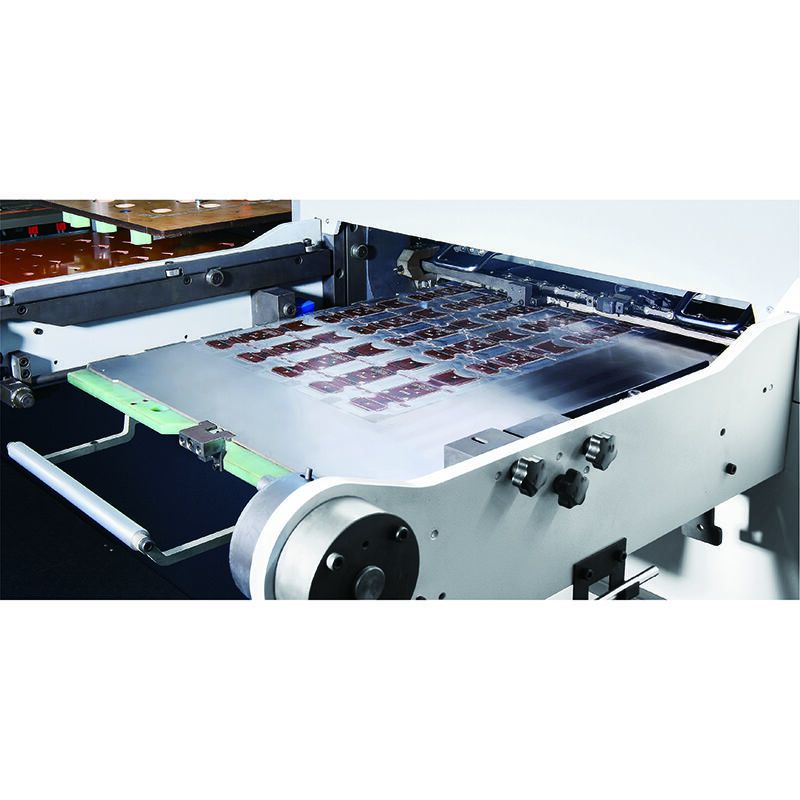หลักการทำงานของเครื่องปั๊มร้อน: ทำงานอย่างไร
เครื่องพิมพ์ร้อนเป็นเครื่องมือที่จำเป็นอย่างยิ่งในอุตสาหกรรมกระดาษและบรรจุภัณฑ์ ใช้สำหรับเพิ่มลวดลายตกแต่งหรือดีไซน์เชิงหน้าที่ลงบนวัสดุที่ทำจากกระดาษหลากหลายประเภท เครื่องเหล่านี้สร้างลักษณะพิมพ์ที่คมชัดและทนทานโดยใช้ความร้อน แรงกด และฟอยล์พิเศษ แต่จะทำงานอย่างไรกันแน่ เครื่องพิมพ์ฟอยล์ร้อน กระบวนการทำงานอาศัยความสมดุลที่แม่นยำของอุณหภูมิ แรงกด และระยะเวลา ซึ่งทำงานร่วมกันเพื่อถ่ายโอนฟอยล์ไปยังพื้นผิวกระดาษ เรามาดูกันว่าหลักการทางวิทยาศาสตร์และกลไกเบื้องหลังเครื่องพิมพ์ร้อนมีอะไรบ้าง โดยอธิบายองค์ประกอบสำคัญและขั้นตอนการดำเนินงานอย่างละเอียด
เครื่องปั๊มฟอยล์คืออะไร
เครื่องพิมพ์ฟอยล์ร้อน เป็นเครื่องมืออุตสาหกรรมที่ออกแบบมาเพื่อเคลือบฟอยล์โลหะหรือฟอยล์สีบางๆ ลงบนวัสดุพิมพ์กระดาษ (วัสดุที่ต้องการตกแต่ง) กระบวนการนี้เรียกว่าการปั๊มร้อน (hot stamping) ใช้เพื่อสร้างโลโก้ ข้อความ ลวดลาย หรือแม้แต่เอฟเฟกต์โฮโลแกรมที่แวววาวบนสิ่งของต่างๆ เช่น กล่องกระดาษแข็งสุดหรู กระดาษบรรจุภัณฑ์คุณภาพสูงสำหรับบุหรี่และแอลกอฮอล์ หรือวัสดุกระดาษทองแดงคุณภาพสูง ต่างจากการพิมพ์ที่ใช้หมึก เครื่องปั๊มร้อนใช้ความร้อนและแรงดันเพื่อยึดฟอยล์เข้ากับกระดาษโดยตรง ส่งผลให้ได้ผิวสัมผัสที่คงทนยาวนาน
ความโดดเด่นของเครื่องปั๊มฟอยล์ร้อนอยู่ที่ความสามารถในการควบคุมปัจจัยสำคัญสามประการ ได้แก่ อุณหภูมิ แรงดัน และระยะเวลาที่ใช้ความร้อนและความดัน (Dwell Time) โดยการปรับแต่งปัจจัยเหล่านี้อย่างแม่นยำ เครื่องปั๊มฟอยล์สามารถทำงานกับวัสดุที่หลากหลาย ตั้งแต่กระดาษหนังสือพิมพ์บาง ๆ ไปจนถึงกระดานลูกฟูกหนา ทำให้มั่นใจได้ว่าฟอยล์จะยึดติดได้อย่างสมบูรณ์โดยไม่ทำลายเนื้อกระดาษ
ส่วนประกอบหลักของเครื่องปั๊มฟอยล์ร้อน
เพื่อให้เข้าใจหลักการทำงานของเครื่องปั๊มฟอยล์ร้อน จำเป็นต้องทราบถึงชิ้นส่วนหลักและวิธีการทำงานร่วมกันของแต่ละส่วน:
-
แผ่นความร้อน (Platen)
แผ่นความร้อน หรือที่เรียกว่าแผ่นพลาเทน เป็นหัวใจหลักของเครื่องปั๊มฟอยล์ร้อน มันคือก้อนโลหะที่ให้ความร้อนจนถึงอุณหภูมิที่กำหนด โดยทั่วไปจะตั้งค่าตามประเภทของกระดาษ (เช่น กระดาษคราฟท์ กระดาษถ่ายภาพผิวมัน เป็นต้น) และชนิดของฟอยล์ที่ใช้ พลาเทนจะรักษาระดับอุณหภูมิให้คงที่ ซึ่งเป็นสิ่งสำคัญเพื่อให้แน่ใจว่าชั้นกาวของฟอยล์ละลายได้อย่างสม่ำเสมอในระหว่างกระบวนการ
-
แม่พิมพ์ (แม่พิมพ์ปั๊ม)
แม่พิมพ์คือแม่พิมพ์โลหะแบบพิเศษที่ขึ้นรูปตามลวดลายที่ต้องการปั๊ม (เช่น โลโก้ หรือลวดลายต่างๆ) ซึ่งติดอยู่ด้านล่างของแผ่นความร้อน เมื่อพลาเทนให้ความร้อน แม่พิมพ์จะถ่ายเทพลังงานความร้อนไปยังฟอยล์ ความแม่นยำของแม่พิมพ์ทำให้มั่นใจได้ว่าลวดลายที่ได้จะคมชัดและตรงกับรูปร่างที่ต้องการอย่างแม่นยำบนวัสดุต่างๆ เช่น กระดาษออฟเซ็ทสองด้าน หรือกระดาษอาร์ต
-
ระบบป้อนฟอยล์
เครื่องปั๊มฟอยล์ร้อนใช้ฟอยล์ร้อนที่ม้วนไว้เป็นวัสดุบางชนิดที่มีสามชั้น ได้แก่
-
ชั้นเคลือบหลุดลอก (เพื่อป้องกันการติดกับแม่พิมพ์)
-
ชั้นตกแต่ง (แบบเมทัลลิก สี หรือโฮโลแกรม มักใช้สำหรับการตกแต่งผิวเคลือบ) แผ่นโลหะ หรือ กระดาษอลูมิเนียม ).
-
ชั้นกาว (ละลายเมื่อได้รับความร้อน เพื่อจับยึดกับพื้นผิวกระดาษ)
ระบบป้อนฟอยล์จะดึงม้วนฟอยล์เข้าไประหว่างแม่พิมพ์กับวัสดุพื้นฐาน โดยจัดตำแหน่งส่วนฟอยล์ใหม่สำหรับการพิมพ์แต่ละครั้ง เพื่อให้มั่นใจว่าไม่มีฟอยล์สูญเสียหรือพิมพ์ผิดตำแหน่ง
-
-
กลไกแรงกด
เครื่องพิมพ์ฟอยล์ร้อนใช้กลไกไฮดรอลิก ลม หรือกลไกมือในการสร้างแรงกด ซึ่งจะดันแม่พิมพ์ที่ถูกให้ความร้อนลงบนฟอยล์และกระดาษ เพื่อให้ชั้นกาวที่หลอมละลายยึดติดฟอยล์ตกแต่งไว้กับวัสดุได้อย่างแน่นหนา ระดับแรงกดจะถูกปรับเปลี่ยนตามประเภทของกระดาษ เช่น แรงกดต่ำสำหรับกระดาษบาร์กเกอร์หรือกระดาษกันคราบน้ำมัน และแรงกดสูงขึ้นสำหรับกระดาษบอร์ดขาวพื้นเทาหนาแน่นหรือกระดาษลูกฟูก
-
ที่ยึดวัสดุพื้นฐาน
พื้นผิวเรียบและมั่นคงนี้ทำหน้าที่ยึดวัสดุพื้นฐาน (เช่น แผ่นกระดาษพิมพ์ กล่องเปล่า ฯลฯ) ให้อยู่ในตำแหน่งขณะพิมพ์ฟอยล์ เพื่อให้มั่นใจว่าวัสดุไม่เคลื่อนที่ ซึ่งเป็นสิ่งสำคัญต่อการจัดตำแหน่งลวดลายให้ตรงเป๊ะ

หลักการทำงานของเครื่องปั๊มร้อน: ขั้นตอนการทำงาน
กระบวนการปั๊มร้อนดูผิวเผินอาจดูเรียบง่าย แต่แต่ละขั้นตอนต้องอาศัยการทำงานประสานกันอย่างแม่นยำของชิ้นส่วนต่าง ๆ ของเครื่องจักร
ขั้นตอนที่ 1: ตั้งค่าเครื่อง
ผู้ปฏิบัติงานตั้งอุณหภูมิของแผ่นความร้อนให้เหมาะสมตามชนิดของฟอยล์และประเภทกระดาษ เช่น ฟอยล์โฮโลแกรมบนกระดาษเลเซอร์อาจต้องใช้อุณหภูมิที่แตกต่างจากฟอยล์ธรรมดาบนกระดาษออฟเซ็ท จากนั้นยึดแม่พิมพ์เข้าที่ ใส่ม้วนฟอยล์ และจัดตำแหน่งกระดาษบนที่ยึด
ขั้นตอนที่ 2: จัดตำแหน่งฟอยล์
ระบบป้อนฟอยล์จะเคลื่อนฟอยล์ส่วนหนึ่งไปวางระหว่างแม่พิมพ์กับชั้นกระดาษ โดยชั้นตกแต่งจะหันลงด้านล่าง toward ผิวกระดาษ
ขั้นตอนที่ 3: ให้ความร้อนและความดัน
เครื่องจะลดแม่พิมพ์ที่ให้ความร้อนลงมา กดฟอยล์ให้แนบกับผิวกระดาษ การรวมกันของความร้อนและความดันจะทำหน้าที่สองประการ คือ ความร้อนจะทำให้ชั้นกาวของฟอยล์ละลาย ในขณะที่แรงดันจะกดชั้นตกแต่งให้ติดแน่นกับผิวกระดาษ เกิดเป็นพันธะทางเคมีถาวร เวลาในการคงแรงกดจะสั้น (โดยปกติ 1−5 วินาที) เพื่อให้เกิดพันธะโดยไม่ทำให้กระดาษเสียหาย
ขั้นตอนที่ 4: ปล่อยและลอกฟอยล์ออก
หลังจากช่วงเวลาที่แม่พิมพ์ค้างไว้ แม่พิมพ์จะยกตัวขึ้น ระบบป้อนกระดาษจะลอกชั้นฟิล์มรองรับและฟอยล์ส่วนที่ไม่ได้ใช้ออกอย่างสะอาด เหลือเพียงชั้นตกแต่งที่ยึดติดแน่นตรงตำแหน่งที่แม่พิมพ์สัมผัสกับกระดาษ
ขั้นตอนที่ 5: ทำซ้ำ
กระบวนการดำเนินไปโดยอัตโนมัติ โดยเลื่อนฟอยล์ไปยังตำแหน่งใหม่และจัดตำแหน่งกระดาษสำหรับการปั๊มครั้งต่อไป ทำให้เครื่องปั๊มฟอยล์สามารถประมวลผลงานจำนวนมากของกระดาษพิมพ์หรือวัสดุบรรจุภัณฑ์ได้อย่างมีประสิทธิภาพ
เหตุใดเครื่องประทับฟอยล์ร้อนจึงมีประสิทธิภาพ
เครื่องปั๊มฟอยล์มีข้อได้เปรียบเฉพาะตัวเมื่อเทียบกับวิธีการตกแต่งอื่นๆ สำหรับกระดาษ:
-
ความงามเหนือกว่า: สร้างเอฟเฟกต์แบบโลหะแท้ แวววาว หรือโฮโลแกรม ซึ่งหมึกพิมพ์ไม่สามารถเลียนแบบได้
-
คุณภาพเชิงสัมผัส: กระบวนการนี้ทำให้เกิดพื้นผิวที่คมชัด มีลักษณะเว้าหรือนูนเล็กน้อยบนกระดาษ ช่วยเพิ่มความรู้สึกหรูหราและมูลค่าของผลิตภัณฑ์
-
ความทนทาน: ฟอยล์ยึดติดกับพื้นผิวกระดาษด้วยพันธะทางเคมี ทำให้ลวดลายมีความต้านทานต่อการขีดข่วนและการจางของสีได้สูง—เหมาะอย่างยิ่งสำหรับสินค้าที่ต้องสัมผัสบ่อย เช่น กระดาษบรรจุภัณฑ์สำหรับบุหรี่และเครื่องดื่มแอลกอฮอล์
-
ความหลากหลายของวัสดุ: เครื่องทำงานได้อย่างสม่ำเสมอบนพื้นผิวกระดาษต่างๆ รวมถึงพื้นผิวที่มีการเคลือบ (กระดาษคอปเปอร์เพลท), พื้นผิวที่มีรูพรุน (กระดาษคราฟท์) และกระดาษชนิดพิเศษ (กระดาษกันไขมัน)
คำถามที่พบบ่อย
เครื่องพิมพ์ฟอยล์ร้อนสามารถใช้งานกับวัสดุกระดาษประเภทใดได้บ้าง
เครื่องพิมพ์ฟอยล์ร้อนสามารถประมวลผลกระดาษและกระดานกระดาษได้อย่างครอบคลุม รวมถึงกระดาษแข็ง กระดาษอาร์ต กระดาษคราฟท์ กระดานลูกฟูก กระดานโลหะ กระดาษบรรจุภัณฑ์สำหรับบุหรี่และแอลกอฮอล์ และกระดาษพิมพ์หรือบรรจุภัณฑ์อื่นๆ เช่น กระดาษออฟเซ็ต และกระดาษกระดานขาวพื้นเทา
การพิมพ์ฟอยล์ร้อนดีกว่าการพิมพ์ธรรมดาสำหรับเอฟเฟกต์โลหะหรือไม่
ใช่ การพิมพ์ฟอยล์ร้อนให้ผิวสัมผัสที่ทนทานมากกว่า สว่างกว่า และสะท้อนแสงได้ดีกว่าหมึกพิมพ์โลหะ แม้ว่าการพิมพ์จะเหมาะกับภาพสีเต็มรูปแบบมากกว่า แต่การพิมพ์ฟอยล์ร้อนเหนือกว่าในการสร้างข้อความหรือโลโก้โลหะที่สะดุดตาและคงทนยาวนานบนกระดาษ
เครื่องปั๊มฟอยล์ร้อนต้องการการบำรุงรักษาเป็นพิเศษหรือไม่
ใช่ การทำความสะอาดแม่พิมพ์และแผ่นความร้อนเป็นประจำมีความจำเป็นเพื่อป้องกันการสะสมของคราบฟอยล์ นอกจากนี้ยังสำคัญที่ต้องตรวจสอบองค์ประกอบการให้ความร้อนอย่างสม่ำเสมอ เพื่อให้มั่นใจว่าสามารถรักษาอุณหภูมิที่แม่นยำและคงที่ตามที่ต้องการสำหรับกระดาษแต่ละประเภท

